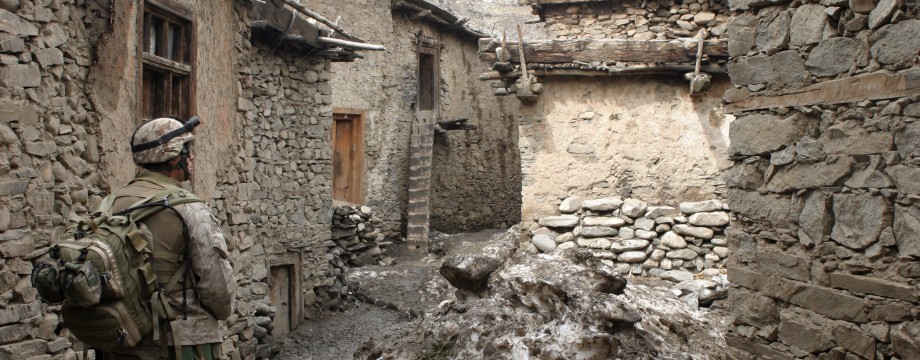“On 24 May, Kilo Company sustained an ineffective IED attack in the vicinity of the Alishang village that resulted in no casualties and minimal battle damage.” — Source: 3/3 Command Chronology for the Period 01 January to 30 June 2005
“Kilo Company sustained an ineffective IED attack in the vicinity of Alishang resulting in no casualties and minimal battle damage (one broken head light on one vehicle).” — Source: 3/3 Command Chronology for the Period 01 January to 30 June 2005
Contents
News
TV crew, Marines escape IED attack
May 29, 2005
Combined Forces Command – Afghanistan Coalition Press Information Center (Public Affairs)
By U.S. Army Sgt. 1st Class Rick Scavetta, Combined Joint Task Force-76 Public Affairs Office
ALISHING VALLEY, Afghanistan – A squad from “Kilo” Company, 3rd Battalion, 3rd Marine Regiment supporting Operation Celtics in this rugged terrain northwest of Jalalabad narrowly escaped the blast of an improvised explosive device May 23.
Insurgents detonated two 107 mm rockets buried in the dirt roadway by remote control. A television camera crew from NBC Nightly News was aboard the Humvee that was hit. But the blast struck just in front of the Humvee, sending a plume of smoke and debris several feet in the air.
“I saw a flash and the dirt rise up,” said Lance Cpl. Clinton Jones, the Humvee driver. “A second later, I heard the boom. It was so loud, I went deaf.”
Jones, 20, of Flagstaff, Ariz., drove through the blast, then slammed on the brakes. Sand and rocks rained down upon the Marines and newsmen riding in the rear of the open-top vehicle.
Cpl. John Pollander, 23, of Cambridge, Mass., leapt from the passenger seat shouting orders for the Marines to dismount, fan out and provide security. The Marines feared the IED was the start of a larger ambush, a tactic used by insurgents in previous attacks.
Before the dust settled, Navy Corpsman Ron Peller, 22, of Tampa Bay, Fla., raced down the rocky path to check for casualties. Peller thought the worst, he said.
“I was in the vehicle just behind,” Peller said. “After the bang, all I saw was a dark cloud rising up.”
Jumping from the Humvee, NBC News correspondent Ron Allen and his crewmen Craig White and Bob Lapp began taping the aftermath. Marines checked their bodies for injuries — miraculously, no one was hurt. Shrapnel had nicked White, sending a trickle of blood down his neck.
Within moments, Marines crept upon craggy hillsides toward a cluster of mud and stone huts. Staring down the sights of their assault rifles, the Marines searched each Afghan house in the area.
From roughly two kilometers away, Marine snipers fixed their scopes on the area. That platoon was also expecting an enemy ambush and had called for air support. Air Force A-10 jet fighters circled overhead as the search continued. At one point, an A-10 pilot swept low through the valley firing flares as a show of force. But the enemy slipped away as night fell over Laghman Province.
The squad of Marines and journalists hunkered down on a nearby knoll as storm clouds approached. Rain, wind and hail bombarded the troops standing watch throughout the night.
By morning, reinforcements had arrived: 2nd Platoon, Company K, who had been watching the attack from their patrol base in the mountains to the north.
Marines have been operating in the area for several weeks, chasing down a Taliban warlord named Abdulah Jan. The insurgent leader, known to locals as “Pashtun,” was behind the firefight that lead to the deaths of two Company K Marines on May 8. Lance Cpl. Nicholas C. Kirven and Cpl. Richard P. Schoener were killed during a mountain battle that lasted several hours and also left several dozen insurgents dead.
Fellow Marines carried their fallen comrades several miles through the hills to a helicopter landing zone overlooking the Alishing river – just a few hundred meters from the site of the IED attack.
As the sun crept over the mountain peaks, drying out the tired troops, Marines launched across the Alishing’s turbulent waters to a string of Afghan huts on the opposite bank – likely the insurgents’ hiding place during the previous night’s attack. The NBC News crew documented the mission.
They found a set of reinforced caves along a slope outside the village. Inside the village, they discovered a few old mortar rounds and some 12.7 mm machine-gun rounds. A large white dog that charged toward one Marine was shot and killed.
But there was no sign of the enemy who detonated the IED. From the village Marines could see the spot on the road where the bomb exploded. It was marked by a large boulder, an obvious landmark for the culprit to know when and where to detonate the buried rockets.
Afghan interpreters questioned several villagers, all of whom claimed to know little about insurgents operating in the area. Meanwhile, it was clear to Marines that the villagers were expecting a search.
“They unlocked all the doors and removed things before we got here. We’ve seen that before,” said Cpl. Matt Carr, 27, of Pittsburgh, Penn. “They knew we would be coming.”
Source: Afghanistan News Center
